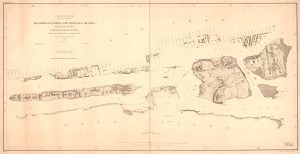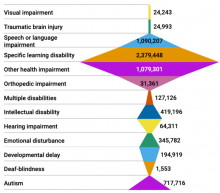Visit the Virginia Department of Education https://www.imdetermined.org/ to learn more.
We created the Accessing Inquiry clearinghouse website to provide guiding strategy (including Universal Design for Learning) and an array of particular tools to support diverse learners in History, Civics, and Social Sciences. This page can help surface the overall needs of your students and point to tools and approaches to support their diverse learning needs.
Empower Student Voice
When students partner with teachers to build upon strengths and develop new skills and knowledge, everyone benefits. Learning directly from students what they want and need is the ideal. The "I'm Determined Youth Credo," a 4-minute video (see above) made by students at a Virginia youth summit for students with disabilities, is explicit about what students want adults to do–and not to do. We begin with this video to honor the principle of the Disability Rights Movement, "Nothing about us without us."
This principle applies to all communities, including the community of multilingual learners.
Learn About Your Students
Learners bring unique interests, strengths, and needs to the classroom. We offer resources specific to students with disabilities and to multilingual learners, many of which are also relevant to students outside of those two intersecting groups.
Students with disabilities represent a broad array of students in school. As many as one in five children between the ages of 3 and 17 have a diagnosable mental, emotional or behavioral disorder. (U.S. Center for Disease Control and Prevention.) These tools offer suggestions and background information.
- Learn about the demographics of students who receive services under the Individuals with Disabilities Education Act (IDEA) nationally and by state. See the Office of Special Education Programs Fast Facts.
Disability Categories - Fast Facts - What is ADHD? Includes text and ASL video on Attention-Deficit Hyperactivity Disorder. Centers for Disease Control and Prevention.
- View 5th grade teacher Eric Crouch in this video as he relates his journey as a learner and teacher who uses Universal Design for Learning to empower all his learners through student-led inquiry. View on the Understood.org website.
- Making mental health a topic of open and non-stigmatized discussion benefits all students. A 2019 Teaching Tolerance article, Demystifying the Mind, describes instances in which schools have integrated mental health literacy into the curriculum.
- The Personalized Learning fact sheet from the National Center for Learning Disabilities offers "Policy & Practice Recommendations" for school and district leaders. The guide provides classroom teachers with insights on best practices in the support of Students with Disabilities.
- 8 Principles for Supporting Students with ADHD. Jennifer Gonzalez. Cult of Pedagogy. (2022).
- I'm not your inspiration, thank you very much. TED Talk, Stella Young. (2014).
There are English Learners among all other sub-groups in school. At least 25% of students who are deaf come from non-English-speaking households. The U.S. Department of Education’s Office of Civil Rights assembled fact sheets on English Learners in Gifted and Talented Programs (where they are underrepresented), English Learners with Disabilities (high percentages in some states, low percentages in others), English Learners Who Are Black, and English Learners and Homelessness. English Learners is the term used in educational legislation; increasingly, terminology that emphasizes the additional knowledge students bring to the classroom is also used interchangeably, including Emerging Bilingual and Multilingual Learner.
- Learn about the demographics of students who are identified as English Learners in your classroom. Facts Sheets are available from the US Department of Education's NCELA and Office of Language Acquisition.
- Mitigating Distress & Maximizing Supports for Refugees from War contains classroom as well as caregiver resources relevant to newcomer students from war-impacted settings.
Scroll down this page to find more information focused on knowing and supporting multilingual learners.
Support Respectful Language about Disability
- See Teaching Resource: Time Out – Spotlight Offensive Language in Primary Sources.
- When possible, ask students how they want you to address their disabilities.
- Establish class ground rules for respectful use of language, including offensive terms that inevitably appear in primary sources. Emerging America's K-12 Disability History Curriculum: Reform to Equal Rights includes strategies and slides to do this.
- Stay informed about how the language changes. An excellent resource is the Disability Language Style Guide from the National Center on Disability and Journalism.
- Also see the American Psychological Association Inclusive Language Guide.
Support Students' Social, Emotional, and Academic Growth
- Is Your Classroom Academically Safe? Jennifer Gonzalez. (2016). Cult of Pedagogy.
- Anxiety: Helping Handout for School and Home (4p.) From the National Association of School Psychologists. Also find other NASP resources, including ones on test anxiety.
- WorryWiseKids - Webpage with 15 things for teachers to think about, from seating to fire drills.
- Experiential art presentation of student anxiety experience "Teacher, May I be Excused to the Toilet? Don’t Feel So Well. Not Sure Why, I Feel Nervous all the Time…" - Music video on YouTube.
- Consider situations and material that might be difficult or even threatening to some students. This could include offensive language, images, and ideas in primary sources (for example, exposé photos of Willowbrook State School in the 1960s and 1970s). Prepare classroom guidelines for addressing such material. Emerging America lesson plans address Cultural Consideration.
- All teachers should consider basic Mental Health First Aid training on how to identify, understand and respond to signs of mental health and substance use challenges among children and adolescents ages 6-18.
- Content Teachers Take Your Seat at the Table: How to empower students by participating in IEP and 504 team meetings. Laurel Peltier, CES. Emerging America blog post.
- Supporting Students with Dyslexia: Free Resources from the National Library Service for the Blind and Print Disabled.
- Help all students to make the classroom more inclusive through children's books that tell the diverse stories that make up America. See Social Justice Books.
Teaching Deaf and Hard-of-Hearing Learners
- Clear Connection: resources for teaching Deaf and hard-of-hearing students - Learning for Justice.
Neurodiverse Learners
- Downloadable infographics on Executive Function, Self-Advocacy, and What Is Neurodiversity? - Landmark College.
Focus Vocabulary and Literacy Instruction
The key to learning social studies for many struggling learners is seamless integration of literacy instruction with learning the key historical thinking skills, including, "Ask meaningful questions." "Analyze sources from multiple perspectives." and "Make and support claims with evidence and good reasoning." Many students with disabilities and English Learners require focused support to unlock the essential vocabulary and modes of discourse (at word/phrase, sentence/paragraph, and document levels).
Vocabulary Instruction
- Emerging America employs the "Bricks and Mortar" Vocabulary strategy to prioritize three or four disciplinary and general academic terms for each lesson.
- Essential, common supports for vocabulary instruction include word walls and word banks. There are many arcane terms in the social studies that can be "given" to students, possibly even for exams. Creating personal vocabulary workbooks builds student ownership of terms.
- Focus vocabulary instruction tools on the terms students need to truly understand a lesson. Useful tools include:
- Frayer Model graphic organizer helps students to analyze a focus term.
- Concept Definition Map graphic organizer helps students to analyze a focus term.
Strategies to support and supplement verbal comprehension
- Specific examples on using visuals, written substitution for spoken conversation, involvement roles for linguistically challenged students with a focus on students with autism.
Deploy Assistive Technology
Assistive technology is a general term used to describe technology tools that are used to help people with disabilities accomplish tasks. Many can be useful to a wide range of students, including English language learners. The most common used forms of assistive technology are speech input software, screen readers, and screen magnifiers.
It is vital to connect and work with the Special Education, ESL, and other specialists in your school district. They know the students, and they bring tremendous expertise to the work. It is essential to find out what tools and strategies the district already deploys. These may include free or subscription services such as Don Johnston or Microsoft. What tools do students already know how to use? How can you extend student capacity?
Screen-Reader-Friendly Documents
More and more people use the automated tools that allow printed text to be spoken aloud and scanned for key words. Organizing and formatting a document so that it is easy for a listener to navigate is a newly important skill for teachers to learn. "Accessibility Checker" software can be useful, especially for writing text that appears on a web page.
Advice to teachers (from tips for using the course-management software Canvas) includes
- not using the same text in the title and the top heading (the reader will read the same phrase twice, confusing the listener)
- using informative headings, not "teaser text" (like: "I couldn't believe what I learned about the Middle Ages!")
- don't use "Click Here" for links, and instead attach the link to a descriptive word or phrase.
Tools for Digital Access
- KidCitizen created a primer guide to making digital education projects fully accessible. See the Emerging America blog post on the guide.
- The National Center on Accessible Educational Materials for Learning at CAST provides technical assistance, coaching, and resources to increase the availability and use of accessible educational materials and technologies for learners with disabilities.
- Deaf Tips: Zoom Meetings - Rochester Institute of Technology Libraries.
- Prioritizing Students with Disabilities in AI Policy - Educating All Learners.
Make Slides Visually Accessible
-
Perkins: "Creating Accessible PowerPoint Presentations for Students with Visual Impairments and Blindness"
Free Tools to Make Text More Accessible
- Rewordify.com - Rewordify offers a wealth of tools. Assess lexile levels. Simplify difficult vocabulary–or give students the option to get definitions and hear difficult terms pronounced. Highlight parts of speech, and more.
- Wordsift.org - Wordsift creates a variety of word clouds that highlight academic terms by subject or difficulty. It offers a visual thesaurus showing relations between terms. Select a term to see it highlighted for every use in a text.
- Youglish.com/ - Gives pronuciation of terms by native speakers of English.
- kids.laws.com offers descriptions of core American documents.
- Newsela.com offers current events and core American documents at multiple reading levels.
- Diffit for differentiating - Using AI for leveled texts, organizers and more
Tools on the Library of Congress website
National Library Service for the Blind and Print Disabled: NLS has been the nation's chief resource for blind and physically handicapped Americans since 1931. NLS at the Library of Congress offers braille and audio reading materials for magazines as well as for books and music resources. Read about how the Braille Officer of the Library of Congress makes use of the collection herself, and information she wants to share with teachers, in her August 2018 post.
Screen Magnification- High resolution images on the Library of Congress site allow all students to zoom in on the details of a visual. Students are often looking for clues to solve a historical puzzle. The magnification tool allows students to see all parts of a primary document with incredible detail. Students with vision problems will benefit from this tool as well.
 https://www.loc.gov/item/gm70000123/
https://www.loc.gov/item/gm70000123/
In this example, students can take an up close tour of Blackwell, Ward, and Randall Islands using the magnification tool.
Model Lesson: Try using the magnification available with a variety of documents with our sample lesson, Nellie Bly 1887: Exposing Treatment of Those with Mental Illness
ZoomText Screen Magnification- The Library of Congress has digitized many different types of text documents. Students sometimes have difficulty reading the text of densely printed books and articles. ZoomText allows students to zoom in closely on particular passages and also display plain text by clicking “show text.” These options make it easier for students to access the material.
 https://chroniclingamerica.loc.gov/lccn/sn83030431/1919-07-20/ed-1/seq-…
https://chroniclingamerica.loc.gov/lccn/sn83030431/1919-07-20/ed-1/seq-…
In this example, students are able to zoom in on picture captions and particular selections from the article.
Model Lesson: See this tool used with a variety of documents with our sample lesson, Reformers and Gangsters in American History from Antebellum to Prohibition.
Voice Output- Using ReadSpeaker, the Library of Congress provides text-to-speech overviews of primary source sets.
In this example, the Born in Slavery: Slave Narratives from the Federal Writers’ Project, 1936 to 1938 features a text-to-speech overview for those with disabilities or whose oral language comprehension outpaces or supports reading comprehension.
Model Lesson: See this tool used with our primary source set, Slavery and Anti-Slavery: Social, Political, and Religious Change (1800-1860)
Multilingual Library of Congress initiatives
The Library of Congress has holdings in many languages, collecting both multilingual US documents and resources from around the world. The Library's international collections include millions of items, in hundreds of different languages and scripts, which focus on societies and cultures around the globe. Librarians in this section also collect resources related to diaspora communities in the United States, and highlight history and cultural resources of relevance to US citizens with ties to various language communities, nations (including US tribal nations), and countries - for example, the connections between Haiti and African American histories of slavery.
For Spanish-speakers, several of the Library's starting pages, including Información General, Preguntas Frequentes (FAQs), and Haga su pregunta (Ask a Librarian) offer information in Spanish. The international collections' Hispanic division includes a focus on the United States Spanish-speaking communities as well as those in other countries. The Palabra Archive contains nearly eight-hundred recordings of poets and prose writers participating in sessions at the Library’s Recording Laboratory in Washington, DC and at other locations around Spain and Latin America. Herencia, the Library’s Spanish-Language Crowdsourcing Project was the first crowdsourcing transcription in Spanish as part of several planned initiatives to make documents more searchable and accessible online.
Supports for English Learners
Learning about multilingual learners / English Learners
¡Colorín colorado! and Understood.org have published essential introductions on teaching ELLs:
- Distance Learning for ELLs Guide
- 10 Things You Need to Learn about Your English Learners
- 5 Myths about ELLs and Special Education.
Dismantling Barriers for English Language Learners in Middle and High School (Edutopia). Offers a set of equity-focused tips and resources for teachers as they plan for meaningful inclusions of multilingual learners across classroom learning opportunities.
Strategies for Teaching English Learners
Translanguaging. Increasingly, educators are embracing the use of multilingual learners' home language as a way to deepen learning, whether or not the teacher speaks any language other than English.
- The Center for Applied Linguistics has an overview of translanguaging that explains this approach.
- Read.Inquire.Write offers guidance on creating an assets-based and translanguaging classroom.
- Bilingual Glossaries and Cognates in Social Studies (scroll to the end) as well as ELA and Math are provided by the NYS Statewide Language Regional Bilingual Education Resource Network.
Langage-Aware Teaching: More than Vocabulary. Teacher reflection on the language demands of any classroom activity, as well as activities students are assigned for homework, is important when multilingual learners are part of the class. Do students need to ask questions? Read text in search of clues about who or what was responsible for an outcome? Identifying the language dimensions of a task, and sharing them along with content objectives, can help support language learning.
Applying the Educating for American Democracy framework. Considering multilingual Americans as important actors in history and civics topics, the Educating for American Democracy Roadmap: Considerations and Contributions of Multilingual Americans guide suggests practical strategies and examples of best practice for teaching civics and history to multilingual learners.
Academic Supports for English Learners
In addition to supports within your school district, there are many curricula and aids to support English Learners in History and Social Science classrooms.
Go-To Strategies: Scaffolding Options for Teachers of English Language Learners, K-12 - Project EXCELL - A trove of 78 activities and tools, with guides to support choosing the best strategy for a given circumstance.
¡Colorín colorado! offers relevant support for teachers in teaching academic disciplines. https://www.colorincolorado.org/
Sentence stems are a powerful tool to support English Learners.
- Sentence Stems. the teacher toolkit - Texas Region 13.
- They Say / I Say: The Moves That Matter in Academic Writing gives a thorough, sophisticated approach to sentence stems. Includes a chapter on teaching Social Studies.
- See an example of sentence stems for the Library of Congress Observe-Reflect-Question primary source analysis tool.
Leveled Text and Thinking Questions
Thinkport Teaching with Primary Sources Inquiry Kits and Research Learning Modules have been developed to support K-12 educators and students. For every United States Inquiry Kit Unit, English for speakers of other languages (ESOL) specialist Ann Morgan has provided paraphrased text for one primary document. The paraphrased text is presented at four different reading levels, each with appropriate questions. This allows every student in the class to have a meaningful experience with a primary source, but at their own pace. Paraphrased text is designed to be placed alongside a copy of the original document, accessible through a link on each page.
Support for Students from Immigrant Families
Learning for Justice posted an excellent guide to Serving ELL Students and Families.
Learning for Justice also posted a guide to supporting students from immigrant families. The guide includes curricula and supports teaching controversial topics.
The Parent and Family Digital Learning Guide is currently offered in English and Spanish.
Guide to Protecting Immigrant Students' Rights to a Public Education - Southern Poverty Law Center, home of Learning for Justice.
Annotated resource guide provides research, best practices, and other articles focused on supporting immigrant families, including those with children who have disabilities, a supplement linked on the Global Family Research Project website
Supports for Students during School Closures
Find resources related to teaching virtually, supporting students during remote learning, and more on our Emerging America compendium post: Resources for Education During a Pandemic.
This article from Learning for Justice, written in April 2020, provides valuable informations and links for supporting students with disabilities during school closures.




